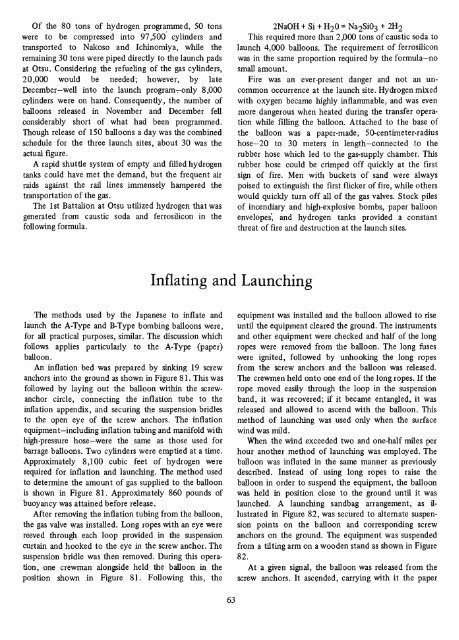Balloon Bomb - Smithsonian Institution Libraries
Balloon Bomb - Smithsonian Institution Libraries
Balloon Bomb - Smithsonian Institution Libraries
Create successful ePaper yourself
Turn your PDF publications into a flip-book with our unique Google optimized e-Paper software.
Of the 80 tons of hydrogen programmed, 50 tons<br />
were to be compressed into 97,500 cylinders and<br />
transported to Nakoso and Ichinomiya, while the<br />
remaining 30 tons were piped directly to the launch pads<br />
at Otsu. Considering the refueling of the gas cylinders,<br />
20,000 would be needed; however, by late<br />
December—well into the launch program—only 8,000<br />
cylinders were on hand. Consequently, the number of<br />
balloons released in November and December fell<br />
considerably short of what had been programmed.<br />
Though release of 150 balloons a day was the combined<br />
schedule for the three launch sites, about 30 was the<br />
actual figure.<br />
A rapid shuttle system of empty and filled hydrogen<br />
tanks could have met the demand, but the frequent air<br />
raids against the rail lines immensely hampered the<br />
transportation of the gas.<br />
The 1st Battalion at Otsu utilized hydrogen that was<br />
generated from caustic soda and ferrosilicon in the<br />
following formula.<br />
2NaOH + Si + H 2 0 = Na 2 Si0 3 + 2H 2<br />
This required more than 2,000 tons of caustic soda to<br />
launch 4,000 balloons. The requirement of ferrosilicon<br />
was in the same proportion required by the formula—no<br />
small amount.<br />
Fire was an ever-present danger and not an uncommon<br />
occurrence at the launch site. Hydrogen mixed<br />
with oxygen became highly inflammable, and was even<br />
more dangerous when heated during the transfer operation<br />
while filling the balloon. Attached to the base of<br />
the balloon was a paper-made, 50-centimeter-radius<br />
hose-20 to 30 meters in length—connected to the<br />
rubber hose which led to the gas-supply chamber. This<br />
rubber hose could be crimped off quickly at the first<br />
sign of fire. Men with buckets of sand were always<br />
poised to extinguish the first flicker of fire, while others<br />
would quickly turn off all of the gas valves. Stock piles<br />
of incendiary and high-explosive bombs, paper balloon<br />
envelopes', and hydrogen tanks provided a constant<br />
threat of fire and destruction at the launch sites.<br />
Inflating and Launching<br />
The methods used by the Japanese to inflate and<br />
launch the A-Type and B-Type bombing balloons were,<br />
for all practical purposes, similar. The discussion which<br />
follows applies particularly to the A-Type (paper)<br />
balloon.<br />
An inflation bed was prepared by sinking 19 screw<br />
anchors into the ground as shown in Figure 81. This was<br />
followed by laying out the balloon within the screwanchor<br />
circle, connecting the inflation tube to the<br />
inflation appendix, and securing the suspension bridles<br />
to the open eye of the screw anchors. The inflation<br />
equipment—including inflation tubing and manifold with<br />
high-pressure hose—were the same as those used for<br />
barrage balloons. Two cylinders were emptied at a time.<br />
Approximately 8,100 cubic feet of hydrogen were<br />
required for inflation and launching. The method used<br />
to determine the amount of gas supplied to the balloon<br />
is shown in Figure 81. Approximately 860 pounds of<br />
buoyancy was attained before release.<br />
After removing the inflation tubing from the balloon,<br />
the gas valve was installed. Long ropes with an eye were<br />
reeved through each loop provided in the suspension<br />
curtain and hooked to the eye in the screw anchor. The<br />
suspension bridle was then removed. During this operation,<br />
one crewman alongside held the balloon in the<br />
position shown in Figure 81. Following this, the<br />
equipment was installed and the balloon allowed to rise<br />
until the equipment cleared the ground. The instruments<br />
and other equipment were checked and half of the long<br />
ropes were removed from the balloon. The long fuses<br />
were ignited, followed by unhooking the long ropes<br />
from the screw anchors and the balloon was released.<br />
The crewmen held onto one end of the long ropes. If the<br />
rope moved easily through the loop in the suspension<br />
band, it was recovered; if it became entangled, it was<br />
released and allowed to ascend with the balloon. This<br />
method of launching was used only when the surface<br />
wind was mild.<br />
When the wind exceeded two and one-half miles per<br />
hour another method of launching was employed. The<br />
balloon was inflated in the same manner as previously<br />
described. Instead of using long ropes to raise the<br />
balloon in order to suspend the equipment, the balloon<br />
was held in position close to the ground until it was<br />
launched. A launching sandbag arrangement, as illustrated<br />
in Figure 82, was secured to alternate suspension<br />
points on the balloon and corresponding screw<br />
anchors on the ground. The equipment was suspended<br />
from a tilting arm on a wooden stand as shown in Figure<br />
82.<br />
At a given signal, the balloon was released from the<br />
screw anchors. It ascended, carrying with it the paper<br />
63
















